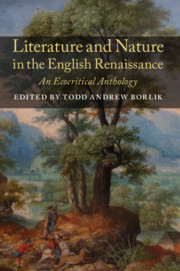Book contents
- Frontmatter
- Contents
- List of Illustrations
- Acknowledgements
- Editorial Principles: Towards the Ecocritical Editing of Renaissance Texts
- Introduction
- PART I Cosmologies
- PART II The Tangled Chain
- PART III Time and Place
- PART IV Interactions
- PART V Environmental Problems in Early Modern England
- Population
- Enclosure
- Deforestation
- The Draining of the Fens
- Pollution
- PART VI Disaster and Resilience in the Little Ice Age
- Appendix A Industrialization and Environmental Legislation in the Early Anthropocene: A Timeline
- Appendix B Further Reading: A Bibliography of Environmental Scholarship on the English Renaissance
Pollution
from PART V - Environmental Problems in Early Modern England
Published online by Cambridge University Press: 05 June 2019
- Frontmatter
- Contents
- List of Illustrations
- Acknowledgements
- Editorial Principles: Towards the Ecocritical Editing of Renaissance Texts
- Introduction
- PART I Cosmologies
- PART II The Tangled Chain
- PART III Time and Place
- PART IV Interactions
- PART V Environmental Problems in Early Modern England
- Population
- Enclosure
- Deforestation
- The Draining of the Fens
- Pollution
- PART VI Disaster and Resilience in the Little Ice Age
- Appendix A Industrialization and Environmental Legislation in the Early Anthropocene: A Timeline
- Appendix B Further Reading: A Bibliography of Environmental Scholarship on the English Renaissance
Summary
While tin was mined in Britain as far back as the Bronze Age, the Elizabethan period witnessed an unprecedented push to exploit the nation's mineral wealth. In 1568, mineral rights were declared to be the exclusive property of the Crown, and the queen Set up a duopoly run by the Society of Mines-Royal and the Company of Mineral and Battery Works. Pits were soon dug or expanded to extract copper in Keswick, iron in the Weald and Forest of Dean, lead in the Peak District, zinc ore in the Mendip Hills, and silver in Cardiganshire. The following excerpt from Spenser's Legend of Temperance (Book 2, Canto 7 of The Faerie Queene) indicates that he took a dim view of this industrial boom, as does the imagery from Book 1 associating the fire-belching dragon with furnaces and forges. Spenser's antipathy to mining owes something to the Roman poet Ovid, but also reflects his belief that the selfish desire to strike it rich was distracting settlers in Ireland and America from farming, which he regarded as a more effective way to promote English colonization. Another factor may have been his grudge against the Lord Treasurer, William Cecil, who was a leading member of the Society of Mines-Royal and a patron of the mining engineer William Humfrey. It is entirely possible that Spenser had some knowledge of ironworks in the Weald or of mining in Cornwall (overseen by his friend Ralegh); in Book 4, he describes the River Dart as “nigh choked with sands of tinny mines” (FQ 4.11.31). He also would have been aware of industrialization in Ireland, such as a proposed mint near Clane, an iron forge at Enniscorthy, or a blast furnace at Mogeely Castle in Munster (Hadfield 217). Although the earliest reference to this furnace dates from 1593, it is conceivable that mining and smelting operations were occurring in the 1580s after Sir John Norreys became President of Munster, as Spenser's description has the immediacy of a first-hand account.
Source: The Faerie Queene (1590), 272–3, 279, 281.
- Type
- Chapter
- Information
- Literature and Nature in the English RenaissanceAn Ecocritical Anthology, pp. 469 - 494Publisher: Cambridge University PressPrint publication year: 2019



